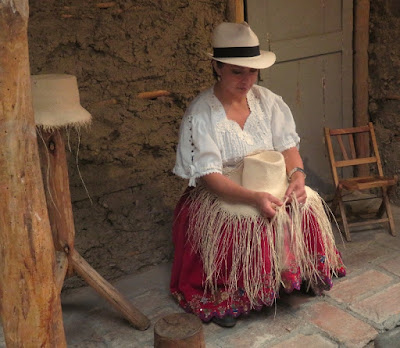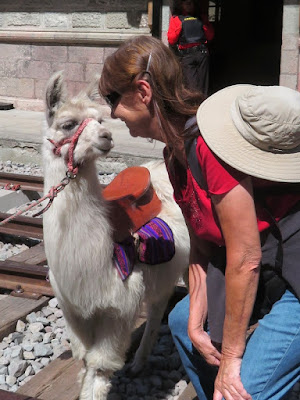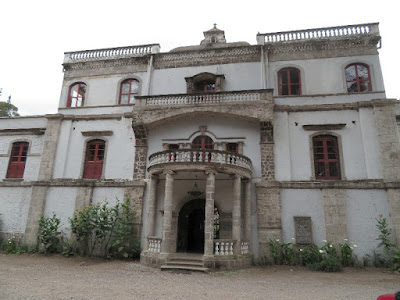Thursday, October 27, 2016
We Made It to Cuenca
After the Devil's Nose train ride, we continued south, stopping at Ingapirca Ruins, the most important Inca complex in Ecuador. The circular Temple of the Sun, which stands in the center of the complex, was once an important ceremonial center.
The landscape team was hard at work.
From there we continued south and finally arrived at Cuenca, our southernmost destination. We stayed at a fancy hotel in the center of town. The rooms are arranged around the dining room in the center.
My travel guidebook said not to come here for the view, and that was definitely true. This is the view from our room.
The next day, we visited the Ortega Hat Factory, where we saw how they make Panama Hats. They are mostly made by women at home, although there was one being made here in the factory as a demonstration.
I guess you can also make them while walking down the street.
The hats are made to this stage -
And then completed here in the factory.
The hats are woven from the fibers of a palm-like plant. Gonzalo, our Road Scholar guide, is demonstrating.
There are lots of hats to choose from in their store.
What do you think?
From there we went up to Turi's Hill, for a breathtaking view of Cuenca. A lot of retired US ex-pats live here in Cuenca, so that adds to the interest.
From the top of the hill we could see the new Cathedral.
There was also a church on the hill, and I ran in to take a look.
We then went to the showroom of Eduardo Vega, a ceramics artist.
After lunch, we did a walking tour of Old Town, going to several churches. This one, the Carmelite Cloister, is hardly ever open. The nuns here are never seen.
We visited the old Cuenca Cathedral, which has statues representing the Last Supper in front of the altar.
We had some off time in the afternoon, so Rosemary and I walked around town. First we went down these steps to one of the 4 rivers in town.
Just beautiful!
Yes, you too!
We went back to the new Cuenca Cathedral, even though we had been there on our tour. Wow - what a door!
Lots of gold leaf inside.
Then we found out that for a $2 donation, we could walk up to the top. What's another 155 steps! We got a nice view of some of the many domes and turrets.
Leaving the cathedral, we happened to see this just-married couple on bicycles dragging some clinking cans. How cute!
Tuesday, October 25, 2016
The Devil's Nose
The next day, after a wakeup call at 4:30, we headed south from Riobamba to the tiny town of Alausi. The town is below a giant statue of St. Peter.
We're here to go on a famous train ride down the Devil's Nose, but we had some time before the train took off, so Rosemary and I decided to go see St. Peter first.
We had to climb a lot of steps, but we made it with time to spare.
The mosaic work on the statue was just incredible.
We went back down and got on the train. Our group had a car almost to ourselves.
This part of the railroad was an engineering marvel in its time - built over 100 years ago, between Alausi and Sibambe, our destination. The two towns are only 6 miles apart, but 2000-feet difference in elevation.
Off we go!
Looking straight down, you can see the train station in Sibambe.
So how does the train get down there? At one point, the train goes backwards down a switchback, then forward again on another switchback.
We made it to the river!
once we got to the river, the train stopped briefly so we could get a picture of the Devil's Nose. You really need a lot of imagination...
Yes, that's it.
There was a museum in Sibambe that showed a picture of the switchback going down the Devil's Nose mountain.
We were greeted at the bottom by some dancers who tried to get us to dance too.
But I spent some time getting to know this cute little alpaca.
All too soon, it was time to get back on the train and climb back up the hill.
We then got back on the bus and headed farther south. Hmmmmm.... I hope that's not dinner....
Sunday, October 23, 2016
Avenue of the Volcanoes
Leaving Otavalo, we headed south for quite a ways, following the "Avenue of the Volcanoes." But it was cloudy as usual, so they were a little difficult to see.
We left very early - before breakfast - then stopped to eat at a fancy hacienda. The Hacienda La Compania is a traditional Ecuadorian hacienda which has been in the family for more than a century.
But it is most famous for its extraordinary rose plantation.
Besides the delicious breakfast, we got to enjoy all the roses in the house.
Outside in the garden, you can barely see that the water in the fountain is covered with rose petals.
After breakfast, we looked around the house a little -
And then went to see the chapel on the property.
Of course there were roses there too.
Then we went to the rose plantation, first seeing the roses in their showroom.
These are specialty dyed roses for the customers in China.
We were each given a long-stemmed rose. Notice how the roses grow straight up here at the equator.
Then we went to see where the roses are grown.
Very long-stemmed!
We also saw how new varieties are grafted onto old ones.
Then we toured the packing and shipping facility.
The roses have a 10-day freshness guarantee, no matter where they are shipped. If you want to order any, their website is www.roses2give.com
After breakfast and the tour, we continued down the Avenue of the Volcanoes. We could occasionally see one.
Here, above the blue bus, you can see a little bit of the glacier on this volcano. Imagine - glaciers at the equator!
Pretty soon, it was time for lunch, so we stopped at another hacienda. I could get used to this...
This time we were entertained by a local band.
A view of the gardens in the back -
And this one had a chapel too!
It was a long day, and we didn't get to our hotel in Riobamba until 5:00.
Subscribe to:
Posts (Atom)






























































